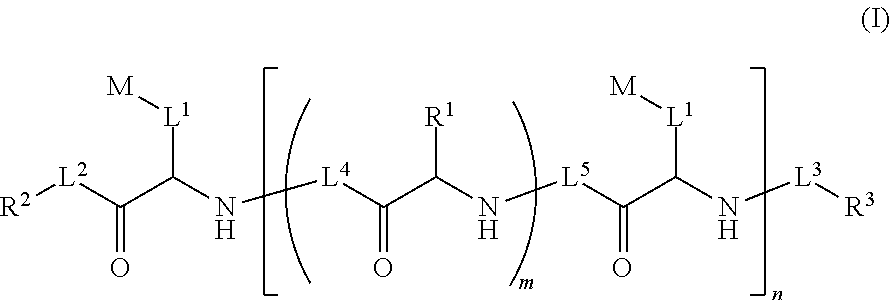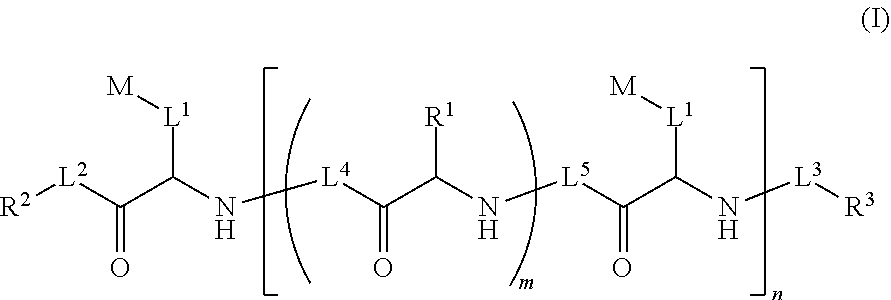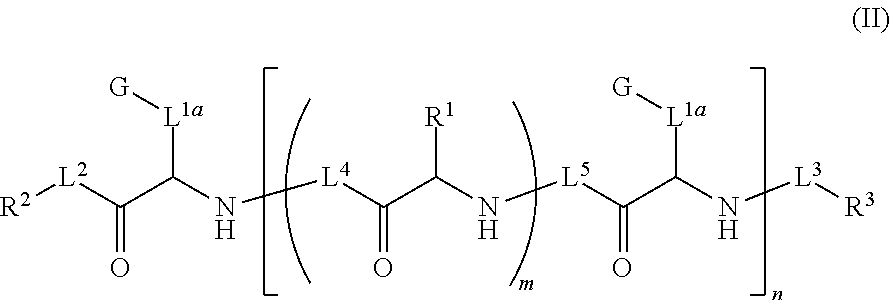Ultra bright polymeric dyes with peptide backbones
a polymer dye and backbone technology, applied in the field of dimer and polymer fluorescent or colored dyes, can solve the problems that dimer and polymer dyes did not achieve the desired brightness increase, and achieve the effect of reducing and/or eliminating the quenching of fluorescent dyes and being easy to incorpora
- Summary
- Abstract
- Description
- Claims
- Application Information
AI Technical Summary
Benefits of technology
Problems solved by technology
Method used
Image
Examples
example 1
[0275]
[0276]The reaction scheme above illustrates an exemplary method for preparing an intermediate useful for preparation of compounds of structure (I), where PG is a suitable protecting group, X is a functional unit that a peptide chain can be built on, the shaded circle is a suitable solid support, and Dye is F′, E′, or Y′.
[0277]Small porous beads are initially treated with functional units, which bind to the surface of the porous beads. Peptide chains are built upon the functional units sites and remain covalently bonded to the bead until they are cleaved. When attached, a peptide chain is immobilized on the solid phase and retained during a filtration process, wherein liquid reagents and by-products of the synthesis are washed away.
[0278]The general cycle of solid phase synthesis is one of repeated cycles of deprotection-wash-coupling-wash. A free N-terminal amine of a peptide, attached to a solid support, is coupled to an N-protected amino acid group (e.g., with Fmoc or Boc). ...
example 2
General Characterization of Oligomer Dyes
[0280]1 mL of deionized water is added to the dried dye compound to re-constitute and establish a concentrated stock of ˜0.3 to 1.0 mM (determined later). Aliquots of each dye construct are analyzed by HPLC-MS to determine identity and relative purity. Electrospray ionization is used to determine the molecular weights of the dye sequences and help to characterize impurities.
[0281]A sample is taken from a concentrated stock using a micropipettor and diluted appropriately in 0.1×PBS (10× to 100×) to be within linear range of the NanoDrop UV-vis spetrophotomer (Thermo Scientific). A blank measurement is performed on the NanoDrop using 0.1×PBS, and then the absorbance of the diluted dye sequence at an appropriate wavelength is recorded. Extinction coefficients (ε) are determined by the total number of fluors (M moieties) in the dye construct, using 75,000 M−1 cm−1 for each fluorescein (F′; read at 494 nm); 34,500 for each pyrene (Y′; read at 343 ...
example 3
General Flow Cytometry Method and Applications
[0283]The general flow cytometry workflow includes the following steps:
[0284]1. Culture and visually observe cells for signs of metabolic stress and / or use fresh, induced, or simulated cells.
[0285]2. Dilute dye compounds to working volumes.
[0286]3. Harvest and prepare cells without killing or inducing apoptosis.
[0287]4. Centrifuge and wash cells with appropriate buffer.
[0288]5. Perform cell counts using hemocytometer and trypan blue exclusion.
[0289]6. Centrifuge and wash cells
[0290]7. Adjust cell density to test size
[0291]8. Apply dye (pre-dilution) or other co-stains of interest.
[0292]9. Incubate the cell / stain / dye mixture.
[0293]10. Centrifuge and wash cells with appropriate buffer.
[0294]11. Re-suspend cells in acquisition buffer.
[0295]12. Acquire cell data by flow cytometry.
[0296]The general workflow described above can be modified accord to specific applications. Some modifications for specific applications are described below.
Live / De...
PUM
| Property | Measurement | Unit |
|---|---|---|
| particle size | aaaaa | aaaaa |
| particle size | aaaaa | aaaaa |
| volume | aaaaa | aaaaa |
Abstract
Description
Claims
Application Information
 Login to View More
Login to View More - R&D
- Intellectual Property
- Life Sciences
- Materials
- Tech Scout
- Unparalleled Data Quality
- Higher Quality Content
- 60% Fewer Hallucinations
Browse by: Latest US Patents, China's latest patents, Technical Efficacy Thesaurus, Application Domain, Technology Topic, Popular Technical Reports.
© 2025 PatSnap. All rights reserved.Legal|Privacy policy|Modern Slavery Act Transparency Statement|Sitemap|About US| Contact US: help@patsnap.com



